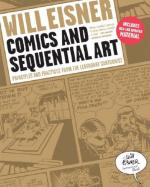
|
| Name: _________________________ | Period: ___________________ |
This test consists of 5 multiple choice questions, 5 short answer questions, and 10 short essay questions.
Multiple Choice Questions
1. Stories can be told through what alone?
(a) Imagery.
(b) Focal points.
(c) Spirit.
(d) Signatures.
2. Calligraphy symbols are rendered with what three things?
(a) Progression, change, style.
(b) Beauty, power, rhythm.
(c) Power, individuality, transcendence.
(d) Beauty, rhythm, and individuality.
3. What particular changes in sound does calligraphy relate to?
(a) Changes in heart palpitations.
(b) Changes in pressure of vocal strings and ink.
(c) Changes in vocal patterns.
(d) Changes in inflection and sound levels in speech.
4. What kind of things does the storyteller use to tell a story in comics?
(a) Balloons and symbols.
(b) Light and dark.
(c) Baggage and ideas.
(d) Depth and perception.
5. Why must the sequential artist and the reader share any experience?
(a) So the artist can get paid.
(b) So the panels are read correctly.
(c) So communication can occur.
(d) So the reader understands the entirety of the piece.
Short Answer Questions
1. As artists tell stories to mass audiences, what do they use as means of arrangement?
2. In a story by Eisner how does he make the text express the sentiment of a scene?
3. What are these artists trying to arrange?
4. What advantage do film and theater have of an audience that is forced to do what?
5. Why is time harder to measure in comics?
Short Essay Questions
1. Give a brief synopsis of Chapter 1: Comics as a Form of Reading.
2. What can the artist be tempted to compromise for the sake of attracting buyers?
3. Why is time more illusory in comics?
4. Briefly give a synopsis of Chapter 3.
5. When inscriptions reappeared in the 18th-century, what did artists use to arrange their thoughts and actions for the audience?
6. Describe the difference between time and timing.
7. What does communicating ideas involve?
8. What obstacle of the eye must the artist try to obliterate?
9. What happens to the hero in one of Eisner's Spirit stories who wishes he could fly?
10. How do people normally measure distance?
|
This section contains 821 words (approx. 3 pages at 300 words per page) |

|




